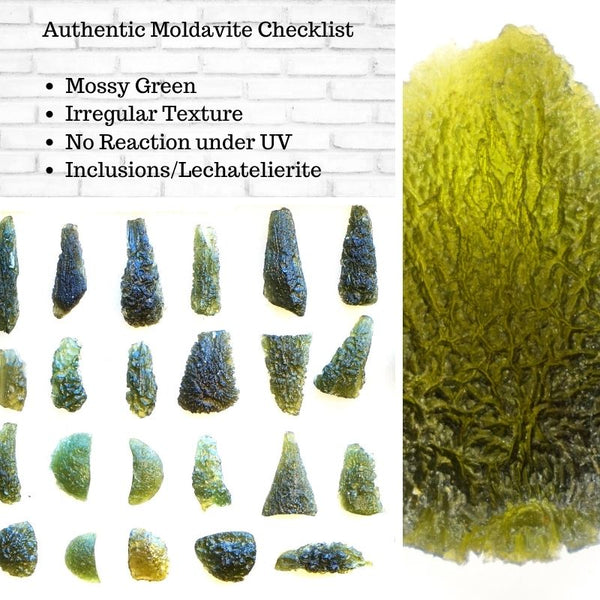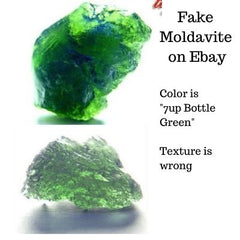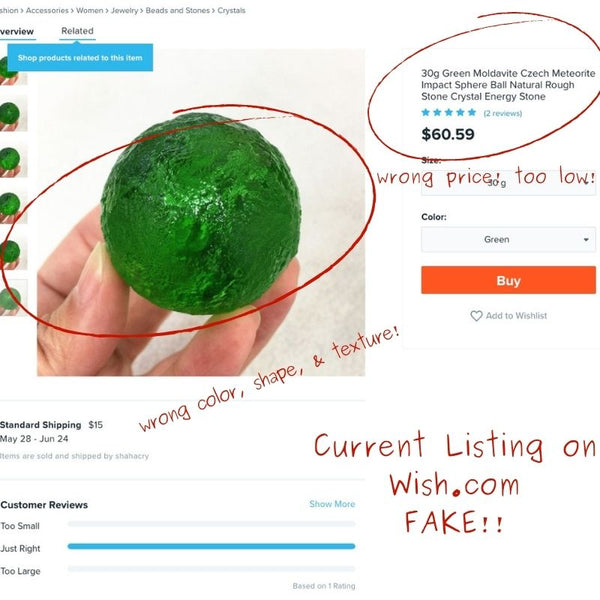
Real vs. Fake Moldavite: A Quick Guide
Share
Buyer beware!
Due to Moldavite’s meteoric rise in popularity, the market is being flooded with fakes.
Moldavite, a glassy green tektite, has captivated serious gem collectors and the metaphysically minded for many reasons. Its formation is the result of a meteorite crash that occurred in Czechoslovakia 14.8 million years ago, making it extremely rare. It is known as the quintessential Starseed stone, since it is a merging of extraterrestrial energy and Earth material. Moldavite has a very high frequency that can often be felt as heat or vibration, which is why it is associated with the activation of psychic and spiritual powers.
Moldavite has now blown up and captured the attention of a much wider, mainstream audience due to popular TikTok videos and social media. The demand is higher than ever, and the supply is coming in at a much slower pace due to COVID and other factors. This has given rise to opportunistic scammers infusing the marketplace with imitations. Many of the fakes are coming out of China/Hong Kong, Thailand, and India.
Some of the fakes are poorly done and obvious. For instance, electric blue Moldavite that practically glows in the dark is an obvious imposter, but you can find it all day long on Etsy and eBay! Other Moldavite imitators have gotten really good at what they do, making it quite difficult to tell the difference. Many of these even come with a "certificate of authenticity," which is much easier to fake than the Moldavite itself.
If Moldavite is calling you, don’t fret! It is still quite possible to find authentic Moldavite. Be sure to only buy from a trustworthy retailer and know what signs to look for to rule out fakes.
Bookmark this little guide and inspect the Moldavite you are considering before you pull out the credit card.

What to Look For
Color: Authentic Moldavite is always some shade of green. It might be light green, forest green, olive green, dark green, or a muddy green. One shade of green that it isn’t is bright florescent green that looks like a 7up bottle. That’s a no! Also, if it is blue, yellow, or red, that’s absolutely not authentic Moldavite. Hard pass!
Luster/Transparency: A lot of fake Moldavites are shiny, slick, or wet looking. Authentic Moldavite looks matte, dull, or earthy. The only time authentic Moldavite looks glassy or shiny is if it is cut or faceted, or if there is a fracture on it. Real Moldavite is also not perfectly transparent--it has some degree of opaqueness. If you can see right through it like glass, it is not real Moldavite.
Texture: Since Moldavite formed quickly from the chaotic event of a meteorite crash, each piece tends to have an irregular, haphazard texture. You will find lumps, bumps, dents, craters, and smooth areas, sometimes all in one piece. A sign of a fake Moldavite would be a very perfect texture. If you see the same pattern and texture throughout the stone, this could indicate that it was manmade in a mold.

Overall Shape/Symmetry: Again, Moldavite formed quickly and sporadically due to a meteorite impact. That’s why it is very rare to find a perfectly symmetrical Moldavite, unless it is a museum quality specimen. You can sometimes find Moldavite that roughly resembles shapes, such as circles, half circles, triangles, and wands. Be suspicious if you see an entire batch of Moldavite for sale in which all of the pieces are the approximately the same shape or size. That’s shady!
Inclusions (Lechatelierite/Bubbles): Sometimes you have to get into Sherlock Holmes mode and whip out the magnifying glass. Real Moldavite will have wavy lines, streaks, and swirls inside of it called Lechatelierite inclusions. These formed quickly from melted sand particles as a result of the meteorite crash. Bubbles of all sizes and shapes are also telltale signs of authentic Moldavite. If you look at a Moldavite under a magnifying loop and see none of this inside, then move on!
Size: Be very suspicious of large Moldavite pieces you see on the market. According to Moldavite expert, Mike Eggleston, the largest Moldavite ever found was 258 grams, and anything over 50 grams usually ends up going straight into private collections. The average weight of a piece of Moldavite is about 4 grams. Authentic Moldavite weighing 1-20 grams is what you tend to find on the market.
Price: Also, beware of Moldavite with a price that seems too good to be true. The price has shot up quite significantly in just the past few months to over $30/gram, depending on the quality. This is a moving target, so be sure to check the current going rate for authentic Moldavite. If you are getting a really good deal, it’s probably fake!

Congratulations! You are now a qualified Moldavite inspector! Armed with this knowledge, it will be much harder to be fooled by imitations. Still, the best advice is to shop at a reputable vender that has long-term relationships and connections with reliable Moldavite sources. Nature’s Treasures of Texas has been providing authentic Moldavite for decades and is a store you can trust!
